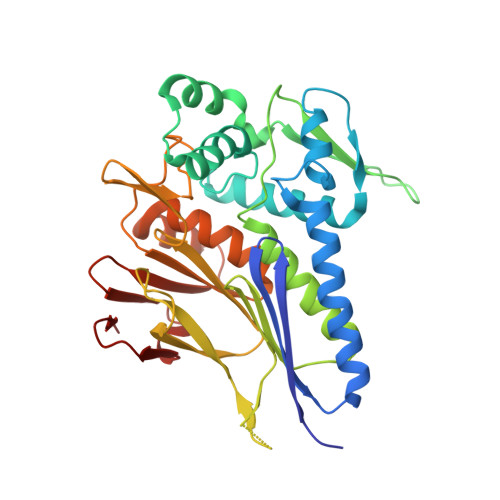Evidence for Posttranslational Protein Flavinylation in the Syphilis Spirochete Treponema pallidum: Structural and Biochemical Insights from the Catalytic Core of a Periplasmic Flavin-Trafficking Protein.
Deka, R.K., Brautigam, C.A., Liu, W.Z., Tomchick, D.R., Norgard, M.V.(2015) mBio 6: e00519-e00515
- PubMed: 25944861
- DOI: https://doi.org/10.1128/mBio.00519-15
- Primary Citation of Related Structures:
4XDR, 4XDT, 4XDU - PubMed Abstract:
The syphilis spirochete Treponema pallidum is an important human pathogen but a highly enigmatic bacterium that cannot be cultivated in vitro. T. pallidum lacks many biosynthetic pathways and therefore has evolved the capability to exploit host-derived metabolites via its periplasmic lipoprotein repertoire. We recently reported a flavin-trafficking protein in T. pallidum (Ftp_Tp; TP0796) as the first bacterial metal-dependent flavin adenine dinucleotide (FAD) pyrophosphatase that hydrolyzes FAD into AMP and flavin mononucleotide (FMN) in the spirochete's periplasm. However, orthologs of Ftp_Tp from other bacteria appear to lack this hydrolytic activity; rather, they bind and flavinylate subunits of a cytoplasmic membrane redox system (Nqr/Rnf). To further explore this dichotomy, biochemical analyses, protein crystallography, and structure-based mutagenesis were used to show that a single amino acid change (N55Y) in Ftp_Tp converts it from an Mg(2+)-dependent FAD pyrophosphatase to an FAD-binding protein. We also demonstrated that Ftp_Tp has a second enzymatic activity (Mg(2+)-FMN transferase); it flavinylates protein(s) covalently with FMN on a threonine side chain of an appropriate sequence motif using FAD as the substrate. Moreover, mutation of a metal-binding residue (D284A) eliminates Ftp_Tp's dual activities, thereby underscoring the role of Mg(2+) in the enzyme-catalyzed reactions. The posttranslational flavinylation activity that can target a periplasmic lipoprotein (TP0171) has not previously been described. The observed activities reveal the catalytic flexibility of a treponemal protein to perform multiple functions. Together, these findings imply mechanisms by which a dynamic pool of flavin cofactor is maintained and how flavoproteins are generated by Ftp_Tp locally in the T. pallidum periplasm. Treponema pallidum, the syphilis spirochete, exploits its periplasmic lipoproteins for a number of essential physiologic processes. One of these, flavin-trafficking protein (Ftp), not only exploits its catalytic center to mediate posttranslational flavinylation of proteins (to create flavoproteins) but also likely maintains the periplasmic flavin pool via its unique ability to hydrolyze FAD. This functional diversity within a single lipoprotein is quite remarkable and reflects the enzymatic versatility of the treponemal lipoproteins, as well as molecular parsimony in an organism with a limited genome. Ftp-mediated protein flavinylation in the periplasm also likely is a key aspect of a predicted flavin-dependent Rnf-based redox homeostasis system at the cytoplasmic membrane of T. pallidum. In addition to its importance in T. pallidum physiology, Ftp homologs exist in other bacteria, thereby expanding our understanding of the bacterial periplasm as a metabolically active subcellular compartment for flavoprotein biogenesis as well as flavin homeostasis.
Organizational Affiliation:
Department of Microbiology, The University of Texas Southwestern Medical Center, Dallas, Texas, USA.



















